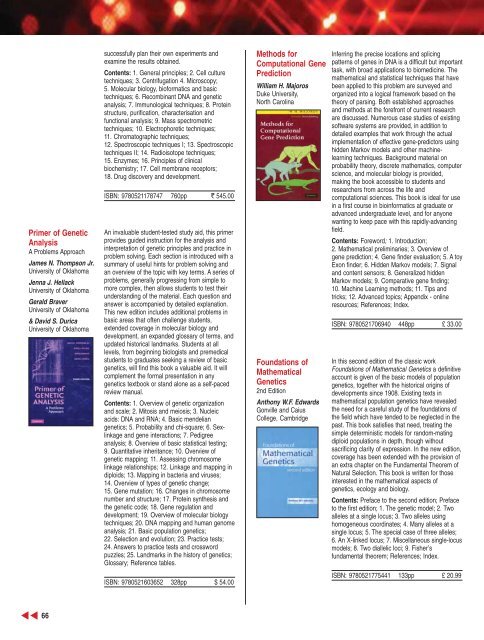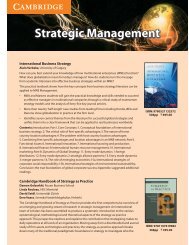ENGINEERING - Cambridge University Press India
ENGINEERING - Cambridge University Press India
ENGINEERING - Cambridge University Press India
You also want an ePaper? Increase the reach of your titles
YUMPU automatically turns print PDFs into web optimized ePapers that Google loves.
Primer of Genetic<br />
Analysis<br />
A Problems Approach<br />
James N. Thompson Jr.<br />
<strong>University</strong> of Oklahoma<br />
Jenna J. Hellack<br />
<strong>University</strong> of Oklahoma<br />
Gerald Braver<br />
<strong>University</strong> of Oklahoma<br />
& David S. Durica<br />
<strong>University</strong> of Oklahoma<br />
successfully plan their own experiments and<br />
examine the results obtained.<br />
Contents: 1. General principles; 2. Cell culture<br />
techniques; 3. Centrifugation 4. Microscopy;<br />
5. Molecular biology, bioformatics and basic<br />
techniques; 6. Recombinant DNA and genetic<br />
analysis; 7. Immunological techniques; 8. Protein<br />
structure, purification, characterisation and<br />
functional analysis; 9. Mass spectrometric<br />
techniques; 10. Electrophoretic techniques;<br />
11. Chromatographic techniques;<br />
12. Spectroscopic techniques I; 13. Spectroscopic<br />
techniques II; 14. Radioisotope techniques;<br />
15. Enzymes; 16. Principles of clinical<br />
biochemistry; 17. Cell membrane receptors;<br />
18. Drug discovery and development.<br />
ISBN: 9780521178747 760pp ` 545.00<br />
An invaluable student-tested study aid, this primer<br />
provides guided instruction for the analysis and<br />
interpretation of genetic principles and practice in<br />
problem solving. Each section is introduced with a<br />
summary of useful hints for problem solving and<br />
an overview of the topic with key terms. A series of<br />
problems, generally progressing from simple to<br />
more complex, then allows students to test their<br />
understanding of the material. Each question and<br />
answer is accompanied by detailed explanation.<br />
This new edition includes additional problems in<br />
basic areas that often challenge students,<br />
extended coverage in molecular biology and<br />
development, an expanded glossary of terms, and<br />
updated historical landmarks. Students at all<br />
levels, from beginning biologists and premedical<br />
students to graduates seeking a review of basic<br />
genetics, will find this book a valuable aid. It will<br />
complement the formal presentation in any<br />
genetics textbook or stand alone as a self-paced<br />
review manual.<br />
Contents: 1. Overview of genetic organization<br />
and scale; 2. Mitosis and meiosis; 3. Nucleic<br />
acids: DNA and RNA; 4. Basic mendelian<br />
genetics; 5. Probability and chi-square; 6. Sexlinkage<br />
and gene interactions; 7. Pedigree<br />
analysis; 8. Overview of basic statistical testing;<br />
9. Quantitative inheritance; 10. Overview of<br />
genetic mapping; 11. Assessing chromosome<br />
linkage relationships; 12. Linkage and mapping in<br />
diploids; 13. Mapping in bacteria and viruses;<br />
14. Overview of types of genetic change;<br />
15. Gene mutation; 16. Changes in chromosome<br />
number and structure; 17. Protein synthesis and<br />
the genetic code; 18. Gene regulation and<br />
development; 19. Overview of molecular biology<br />
techniques; 20. DNA mapping and human genome<br />
analysis; 21. Basic population genetics;<br />
22. Selection and evolution; 23. Practice tests;<br />
24. Answers to practice tests and crossword<br />
puzzles; 25. Landmarks in the history of genetics;<br />
Glossary; Reference tables.<br />
ISBN: 9780521603652 328pp $ 54.00<br />
Methods for<br />
Computational Gene<br />
Prediction<br />
William H. Majoros<br />
Duke <strong>University</strong>,<br />
North Carolina<br />
Foundations of<br />
Mathematical<br />
Genetics<br />
2nd Edition<br />
Anthony W.F. Edwards<br />
Gonville and Caius<br />
College, <strong>Cambridge</strong><br />
Inferring the precise locations and splicing<br />
patterns of genes in DNA is a difficult but important<br />
task, with broad applications to biomedicine. The<br />
mathematical and statistical techniques that have<br />
been applied to this problem are surveyed and<br />
organized into a logical framework based on the<br />
theory of parsing. Both established approaches<br />
and methods at the forefront of current research<br />
are discussed. Numerous case studies of existing<br />
software systems are provided, in addition to<br />
detailed examples that work through the actual<br />
implementation of effective gene-predictors using<br />
hidden Markov models and other machinelearning<br />
techniques. Background material on<br />
probability theory, discrete mathematics, computer<br />
science, and molecular biology is provided,<br />
making the book accessible to students and<br />
researchers from across the life and<br />
computational sciences. This book is ideal for use<br />
in a first course in bioinformatics at graduate or<br />
advanced undergraduate level, and for anyone<br />
wanting to keep pace with this rapidly-advancing<br />
field.<br />
Contents: Foreword; 1. Introduction;<br />
2. Mathematical preliminaries; 3. Overview of<br />
gene prediction; 4. Gene finder evaluation; 5. A toy<br />
Exon finder; 6. Hidden Markov models; 7. Signal<br />
and content sensors; 8. Generalized hidden<br />
Markov models; 9. Comparative gene finding;<br />
10. Machine Learning methods; 11. Tips and<br />
tricks; 12. Advanced topics; Appendix - online<br />
resources; References; Index.<br />
ISBN: 9780521706940 448pp £ 33.00<br />
In this second edition of the classic work<br />
Foundations of Mathematical Genetics a definitive<br />
account is given of the basic models of population<br />
genetics, together with the historical origins of<br />
developments since 1908. Existing texts in<br />
mathematical population genetics have revealed<br />
the need for a careful study of the foundations of<br />
the field which have tended to be neglected in the<br />
past. This book satisfies that need, treating the<br />
simple deterministic models for random-mating<br />
diploid populations in depth, though without<br />
sacrificing clarity of expression. In the new edition,<br />
coverage has been extended with the provision of<br />
an extra chapter on the Fundamental Theorem of<br />
Natural Selection. This book is written for those<br />
interested in the mathematical aspects of<br />
genetics, ecology and biology.<br />
Contents: Preface to the second edition; Preface<br />
to the first edition; 1. The genetic model; 2. Two<br />
alleles at a single locus; 3. Two alleles using<br />
homogeneous coordinates; 4. Many alleles at a<br />
single locus; 5. The special case of three alleles;<br />
6. An X-linked locus; 7. Miscellaneous single-locus<br />
models; 8. Two diallelic loci; 9. Fisher’s<br />
fundamental theorem; References; Index.<br />
ISBN: 9780521775441 133pp £ 20.99<br />
66

















